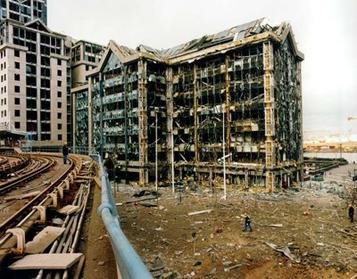The Irish Republican Army (IRA), an Irish paramilitary organization, ended its 18-month ceasefire on February 9, 1996, with a devastating bombing in London’s Canary Wharf. This attack not only resulted in the loss of two innocent lives but also caused extensive damage to the financial district, sparking renewed fears and highlighting the fragility of the peace process in Northern Ireland. The event served as a stark reminder of the challenges faced in achieving a lasting resolution to the long-standing conflict.
The ceasefire, which had been in place since August 1994, had brought a period of relative calm to the troubled region. It was seen as a step towards finding a peaceful solution to the conflict between the IRA, seeking a united Ireland, and the British government, which aimed to maintain control over Northern Ireland.
However, the London bombing shattered the hopes of many who believed that the ceasefire would lead to a permanent end to the violence. The bomb, estimated to weigh around 1,500 pounds, was placed in a truck and detonated outside a major office building in Canary Wharf. The explosion caused significant damage to surrounding buildings and infrastructure, including the nearby South Quay DLR station.
The IRA claimed responsibility for the attack, stating that it was in response to the perceived lack of progress in the peace process and the British government’s failure to meet their demands. This act of violence sent shockwaves through the international community and reignited concerns over the Northern Ireland conflict.
The aftermath of the bombing saw a surge in tensions between the IRA and the British government. The British Prime Minister at the time, John Major, condemned the attack and vowed to bring those responsible to justice. The police launched a major investigation, and several arrests were made in connection with the bombing.
The Canary Wharf bombing was not an isolated incident during this period. In the months leading up to the attack, there were several smaller-scale bombings and shootings, indicating a growing sense of unrest and dissatisfaction among certain factions within the IRA. These incidents, coupled with the failure to make significant progress in the peace negotiations, eventually led to the collapse of the ceasefire.
The repercussions of the bombing were felt not only in London but also in Northern Ireland. The attack further polarized communities and deepened the divide between those advocating for a united Ireland and those supporting the status quo. It also highlighted the complexities and challenges of achieving a lasting resolution in a conflict that had been ongoing for decades.
In the years following the Canary Wharf bombing, efforts were made to revive the peace process and bring about a negotiated settlement. The Good Friday Agreement, signed in 1998, marked a significant milestone in the peace process and led to the establishment of a power-sharing government in Northern Ireland. This agreement helped to bring an end to the violence and create a framework for addressing the underlying issues that had fueled the conflict.
Today, Northern Ireland continues to grapple with the legacy of the Troubles, as the conflict is known. The events of 1996, including the IRA’s decision to end the ceasefire with the London bombing, serve as a reminder of the challenges faced in achieving peace and reconciliation. They also underline the importance of ongoing dialogue, understanding, and compromise in resolving deeply entrenched conflicts.
While the Canary Wharf bombing was a tragic and devastating event, it ultimately played a role in galvanizing efforts to find a peaceful resolution to the Northern Ireland conflict. The lessons learned from this dark chapter in history continue to shape the region’s path towards a more peaceful and inclusive future.
SEO Excerpt:
The IRA’s decision to end its ceasefire with the 1996 London bombing marked a turning point in the Northern Ireland conflict. This article explores the historical context, the impact of the bombing, and the subsequent efforts to achieve a lasting resolution. Discover how this tragic event highlighted the challenges faced in the peace process and the ongoing journey towards peace and reconciliation in Northern Ireland.

